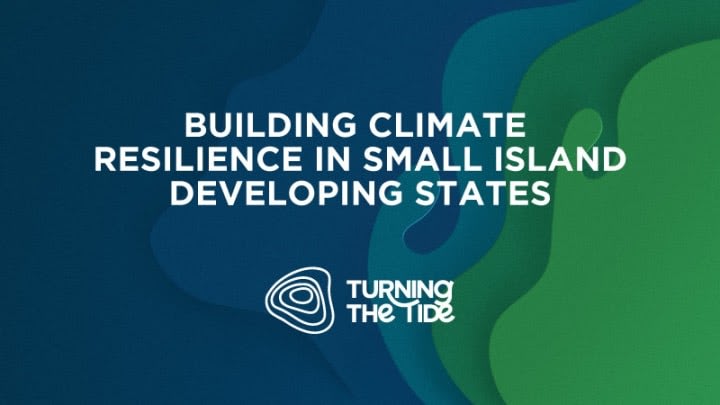
Because of their high vulnerability to the effects of climate change and extreme weather events, small island developing states have often been at the forefront of the climate change fight.
Fiji, which experiences on average one cyclone per year, was the very first country to formally ratify the Paris Agreement — the landmark agreement to combat climate change reached in 2015. And this past September, U.N. Secretary-General António Guterres acknowledged that SIDS are on the frontline of protecting and conserving the ocean.
During the high-level meeting reviewing progress on the priorities of SIDS at the 74th session of the U.N. General Assembly, Guterres highlighted the importance of helping these nations achieve the goals of the 2030 Agenda as it “will yield tools, lessons and examples for the entire world.”
“There's so much funding behind climate change right now, one of the challenges that we have is accessing that funding.”
— Litiana Bainimarama, principal officer, Fiji National Disaster Management OfficeBut when an extreme weather event strikes, the geography and remoteness of SIDS often make it difficult for humanitarian aid to reach them, meaning they have little choice but to be self-sustaining during the immediate aftermath of a disaster. Heavy dependence on the tourism sector also makes their small-scale economies vulnerable to disasters, which can offset years of development and progress, and take years to recover from.
To cope with the increasing effects of climate change and to better safeguard their sustainable development, disaster risk reduction, or DRR, has become increasingly important for many island nations.
Globally, governments and other donors spent $5.2 billion on DRR from 2005 to 2017, representing 3.8% of the total humanitarian financing during that period, according to a 2019 United Nations report on DRR. Approximately 90% of international funding for disasters goes toward recovery work, leaving little over 10% for prevention — a gap that could widen if climate change leads to the “unprecedented extreme weather events” anticipated by the Intergovernmental Panel on Climate Change.
Listen to the Turning the Tide podcast. Via SoundCloud.
Risk reduction rather than emergency response
According to Litiana Bainimarama, principal officer at the National Disaster Management Office, or NDMO, of Fiji, disaster management used to be more of a humanitarian issue, but we're now starting to see it as a development issue.
“That's a plus, especially for us small island developing states where disasters take such a huge toll on our economic growth and social development,” she said.
In 2016, the country was hit by Tropical Cyclone Winston which impacted 62% of the population, caused F$2 billion ($909 million) in damage, and killed 44 people.
Disaster risk reduction “is for long-term impacts,” Bainimarama said, adding that it protects the country’s development work in terms of economic and social growth. This is especially true, she said, if a country invests in resilient infrastructure, in order to prevent losing funds allocated for development to recovery and rehabilitation.
But getting agencies to invest in DRR rather than in disaster response is difficult, she said. Investing in risk reduction now, she explained, means needing less investment in response and recovery later, adding that one of the main challenges is “changing that mindset.”
While NDMO gets assistance from a variety of funders — including the Australian Department of Foreign Affairs and Trade, the European Commission, and the World Bank Group — Bainimarama highlighted the government of Japan’s support, including a recently signed agreement for a Stand-by Loan for Disaster Recovery and Rehabilitation worth up to $50 million. Fiji can access the funds in the event of a disaster “on the condition that we have a disaster risk reduction policy in place and implemented,” she said.
“The Government of Japan encourages us to implement disaster risk reduction and not just wait for things to happen and they would give us a loan, so it actually makes us implement DRR activities in-country. It's a good mechanism,” Bainimarama added.
Integrating climate change and DRR efforts
Inia Seruiratu, former minister for rural and maritime development and national disaster management and meteorological services, wrote in the foreword of Fiji’s National Disaster Risk Reduction Policy 2018-2030 that “disaster risk reduction is a top priority for Fiji and should be mainstreamed into all policies, plans, and practice.”
However, one of the main challenges facing Fiji is the “fragmented coordination with DRR and climate change working in separate silos,” according to Bainimarama; the climate change unit is under the Ministry of Economy, while DRR lies under the Ministry of Rural and Maritime Development and National Disaster Management.
“If there was more coordination, the impact on the ground would be greater,” she said, adding that there is a thin line between climate change adaptation and disaster risk reduction. Then there is the issue of a lack of funds available for DRR efforts specifically.
“There's so much funding behind climate change right now, one of the challenges that we have is accessing that funding,” Bainimarama said.
Promoting local solutions
According to Bainimarama, one of Fiji’s big strides has been the development of the National Disaster Risk Reduction Policy, which has enabled it to localize the Sendai Framework for DRR, a roadmap for making communities safer and more resilient to disasters.
The policy is based on consultations with government agencies, the private sector, civil society organizations and communities, and will be implemented over phases until 2030. “It's basically the Sendai framework in a more local context,” Bainimarama said.
Resilience building efforts have to be adapted to SIDS because of their unique context and the development of integrated approaches to managing risks are essential, Sarah Selby, a resilient development adviser, told Devex by email, explaining how important it is that resilient development actions are anchored in local needs.
“Community members, including those most at risk, need to be engaged as key actors in designing plans, activities, and solutions that are relevant to them to ensure locally relevant sustainable actions that respond to local needs,” she added.
One example from Fiji includes a community in the western division, which led relocation efforts following a deadly landslide in 2012. “The community decided to relocate so they requested the government to assist, but otherwise it was community-led — they took the initiative and did the groundwork,” Bainimarama said.
NDMO also works at the community level to provide community training, which includes engaging communities in “doing hazard mapping, in identifying risks that they would be vulnerable to, and how they could mitigate those risks,” she added.
It’s also important to preserve the knowledge and local practices of the communities.
“There's traditional strength within communities that they can use to strengthen their resilience,” she said, listing resilient crops and traditional ways of protecting and reinforcing homes as examples.
The role of data in risk reduction
But the challenges faced by SIDS need solutions looking beyond traditional practices — innovation and advances in satellite data present new opportunities for disaster risk reduction efforts.
In many low- and middle-income countries, information is rarely managed and stored in a way that can be reused and easily accessed, said Niels B. Holm-Nielsen, global lead for disaster risk management and resilience at the World Bank. That is a big problem when you work on disaster risk, because it is information- and data-intense, he said.
“If you don't understand or have measurements of what's going on then it's really hard to make good, informed decisions,” Holm-Nielsen said.
What is the International Partnership Programme?
The UK Space Agency’s International Partnership Programme is a £152 million ($199 million) multiyear program launched in 2015, which uses U.K. organizations’ space knowledge, expertise, and capability to provide a sustainable, economic, or societal benefit to low- and middle-income countries. It is funded by the Department for Business, Energy & Industrial Strategy’s Global Challenges Research Fund, a £1.5 billion fund that forms part of the U.K. government’s official development assistance commitment.
The CommonSensing project — based on a partnership between Fiji, Solomon Islands, and Vanuatu, together with a consortium of international partners, as part of the U.K. Space Agency’s International Partnership Programme — is helping to build the NDMO’s geospatial capabilities.
“In terms of data collection, that's something we hope the CommonSensing project is going to help us with, storing the data and being able to make more evidence-based decisions,” Bainimarama said.
According to Einar Bjorgo, director of Satellite Analysis and Applied Research at UNOSAT, “satellite data is extremely useful because we now have repeat coverage every single day and we’re able to look at what is happening in terms of a natural disaster.”
Combining geospatial information with other data — such as population distribution, terrain, land cover, and predicted storm tracks — also present opportunities for risk reduction, Bjorgo explained.
“That information can then be stored for the future when you need to make decisions for preventive purposes,” he said, adding that the project aims to ensure that data is made accessible locally, at the national level, and then to train the people on how to use the data.
Visit the Turning the Tide series for more coverage on climate change, resilience building, and innovative solutions in small island developing states. You can join the conversation using the hashtag #TurningtheTide.

Read more from the Turning the Tide series
► Too late for red tape on climate action, says Farhana Yamin




